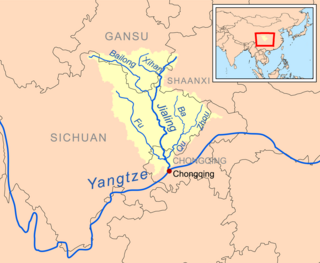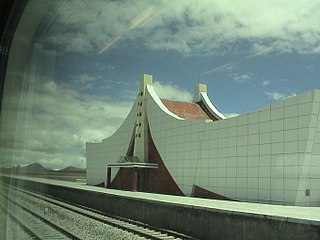
The Yangtze or Yangzi is the longest river in Asia, the third-longest in the world and the longest in the world to flow entirely within one country. It rises at Jari Hill in the Tanggula Mountains and flows 6,300 km (3,900 mi) in a generally easterly direction to the East China Sea. It is the seventh-largest river by discharge volume in the world. Its drainage basin comprises one-fifth of the land area of China, and is home to nearly one-third of the country's population.

The Yellow River is the second-longest river in China, after the Yangtze River, and the sixth-longest river system in the world at the estimated length of 5,464 km (3,395 mi). Originating in the Bayan Har Mountains in Qinghai province of Western China, it flows through nine provinces, and it empties into the Bohai Sea near the city of Dongying in Shandong province. The Yellow River basin has an east–west extent of about 1,900 kilometers (1,180 mi) and a north–south extent of about 1,100 km (680 mi). Its total drainage area is about 795,000 square kilometers (307,000 sq mi).

The Liao River is the principal river in southern Northeast China, and one of the seven main river systems in mainland China. Its name derived from the Liao region, a historical name for southern Manchuria, from which the Liaoning province, Liaodong Peninsula and Liao dynasty also all have derived their names. The river is also popularly known as the "mother river" in Northeast China. Coursing 1,345 kilometres (836 mi) long, the Liao River system drains a catchment basin of over 232,000 square kilometres (90,000 sq mi), but its mean discharge is quite small at only about 500 cubic metres per second (18,000 cu ft/s), about one-twentieth that of the Pearl River. The Liao River has an exceedingly high sediment load because many parts of it flow through powdery loess.

The Jialing River, formerly known by numerous other names, is a major tributary of the Yangtze River in the Sichuan Basin. It is named after the Jialing Valley in Feng County, Shaanxi through which it flows.

Nagqu is a prefecture-level city in the north of the Chinese autonomous region of Tibet. On May 7, 2018, the former Nagqu Prefecture was officially declared the sixth prefecture-level city in Tibet after Lhasa, Shigatse, Chamdo, Nyingchi and Shannan. The regional area, covering an area of 450,537 km2 (173,953 sq mi), is bordered by Bayingolin and Hotan Prefectures of Xinjiang to the north, Haixi, Yushu Prefectures of Qinghai and Chamdo to the east, Nyingchi, Lhasa and Shigatse to the south, Ngari Prefecture to the west. As of the 2010 census, it had a population of 462,381.

The Dadu River, known in Tibetan as the Gyelmo Ngul Chu, is a major river located primarily in Sichuan province, southwestern China. The Dadu flows from the eastern Tibetan Plateau into the Sichuan Basin where it joins with the Min River, a tributary of the Yangtze River. Measured from its geographic source, the Dadu is actually longer than the Min and thus forms the main stem of the Min River system.

Gaocheng is one of eight districts of the prefecture-level city of Shijiazhuang, the capital of Hebei Province, North China, on the upper reaches of the Hutuo River (滹沱河). The city has a total area of 836 square kilometres (323 sq mi) and in 2010 had a population of 743,000.

The Tanggula, Tangla, Tanglha, or Dangla Mountains are a mountain range in the central part of the Tibetan Plateau in Tibet. Administratively, the range is in the Nagqu Prefecture of the Tibet Autonomous Region, with the central section extending into nearby Tanggula Town and the eastern section entering the Yushu Tibetan Autonomous Prefecture of Qinghai province.

The Zhi Qu (Tibetan) or Tongtian River, is a 1,012 km (629 mi) long, flows within Qinghai Province of northwest China. It is within the Yangtze River Basin—Chang Jiang drainage basin.

Gyêgu Subdistrict, formerly a part of the Gyêgu town is a township-level division in Yushu, Yushu TAP, Qinghai, China. The name Gyêgu is still a common name for the Yushu city proper, which include Gyêgu subdistrict and three other subdistricts evolved from the former Gyêgu town. The four subdistricts altogether forms a modern town which developed from the old Tibetan trade mart called Jyekundo or Gyêgumdo in Tibetan and most Western sources. The town is also referred to as Yushu, synonymous with the prefecture of Yushu and the city of Yushu.

Donghe District is a district of Baotou, the largest city of Inner Mongolia, People's Republic of China.
The Togtogquwo railway station or the Tuotuohe railway station is a station on the Chinese Qinghai–Tibet Railway. It is located at 34°13′59.26″N92°26′44.80″E near the railway bridge over the Tuotuo River, which is considered the headwaters of China's great Yangtze River..

The bridges and tunnels across the Yangtze River carry rail and road traffic across China's longest and largest river and form a vital part of the country's transportation infrastructure. The river bisects China proper from west to east, and every major north-south bound highway and railway must cross the Yangtze. Large urban centers along the river such as Chongqing, Wuhan, and Nanjing also have urban mass transit rail lines crossing the Yangtze.

Tanggulashan, or Dangla Town, is a town in the southwest of Qinghai province, China. It forms the southern exclave of the county-level city of Golmud, in Haixi Mongol and Tibetan Autonomous Prefecture, partially administrated by Amdo County, Tibet Autonomous Region since 1963 and still officially a territory of Yushu Prefecture, Qinghai under trust administration of Golmud, Haixi Prefecture, Qinghai. Before the local administrative reform of 2005, it was known as Tanggula Township (唐古拉乡). It is the only place in China simultaneously under jurisdiction of three prefectures.
The Dangqu or Dam Chu is a river in Qinghai province in the People's Republic of China. It is the geographic headwater of the Yangtze River, although the nearby Ulan Moron is traditionally regarded as the source.
The Batang River or Zha Chu, whose two sources are Za Qu and Bai Qu, is an 88-kilometre (55 mi) long river in Yushu Tibetan Autonomous Prefecture, south-eastern Qinghai province, in the People's Republic of China. The river begins in the highlands of central Yushu County and flows easterly through the townships of Batang (巴塘乡) and Gyêgu before meeting the Tongtian River at the border of Yushu County with Chindu County. The Tongtian is the main stem of the Yangtze River, and its confluence with the Batang is traditionally considered to mark the beginning of the Jinsha section of the Yangtze. The Batang River's watershed covers 2,466 square kilometres (952 sq mi) and its average flow is 29 m³ per second.
The Batang or Ba Chu is an 140-kilometer (87 mi) long river in Sichuan province in the People's Republic of China. It is located near Batang town (巴塘镇), not the Batang township (巴搪乡) near Gyêgu in Qinghai.
The Red River or Red Water is an important feature in the mythological geography of Chinese literature, including novels and poetry over a course of over two millennia from the Warring States to early Han dynasty era poetry of the Chuci onward. The Red River is one of the mythological rivers said to flow from Kunlun, a mythological land, with mountainous features. Translations into English include "Scarlet River".














